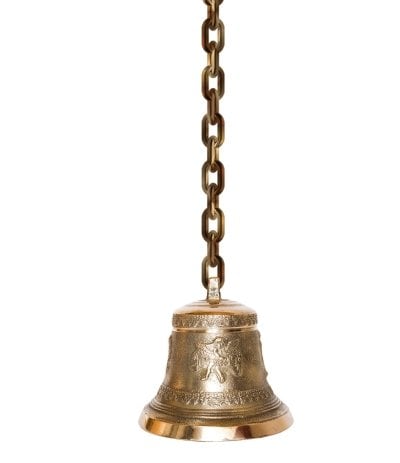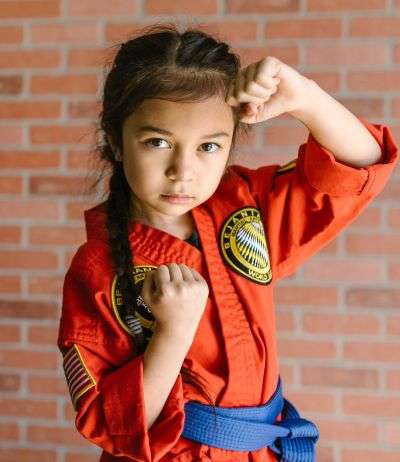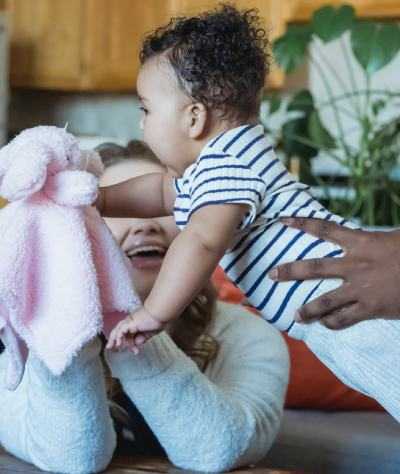TOP 30 BABY GAMES (0-3 YRS)

You have a cute little baby who loves to play? Here is our massive list of the top 30 baby games to keep your little one entertained!
What games can you play with a baby?
Newborns are curious about exploring the world around them! Baby games that gently exercise their senses are great for newborns. Here are some baby games for 0 to 6 months old babies.
- Ringing Bells

Baby games with sound are excellent for grabbing your baby’s attention. Watch the little one enjoy various sounds.
No. of Players
1+
Requirements
- Bells of various sizes and shapes
Directions
- Make sure your baby is placed in an infant seat.
- Choose a bell and start ringing it above your little one’s head.
- Keep ringing the bell in various positions like to the left or right of your child.
- Observe your baby and notice if her/his eyes follow the ringing bell.
Outcome
- Your baby is sure to enjoy and be fascinated with the rhythmic sounds made by ringing bells.
- Ringing bells form the earliest lesson for associating sound with the objects that make it.
2. Stomach Play
Your baby benefits to a greater extent from playing in a prone position (lying face downwards or on the stomach) regularly.
No. of Players
1+
Requirements
None
Directions
- Lay down your baby on her tummy and station yourself on the same level.
- Start making various faces and sounds in order to encourage raising her/his head.
- Place bright & colourful toys in front of your baby in such a manner that they are clearly visible. Grab your little one’s attention with any toy and move it back & forth slowly so that it can be easily.
- Place your baby’s favourite toys at a distance and encourage your baby to crawl towards them slowly.
Outcome
- Raising the head on a regular basis strengthens the upper body and neck muscles.
- Through this activity your baby develops motor planning as your baby moves the body with appropriate sequence and timing in order to execute the bodily movements with elegant control.
- Regular play time in a prone position has been scientifically proven to improve gross motor skills on a normal time schedule. Lack of play in a prone position hinders development.
3. Kung Fu Baby

Infants love to kick out their little legs. Here is excellent kick training advice!
No. of Players
1+
Requirements
- Pillows
- Plastic Plate
Directions
- Put a blanket on the floor and then place your baby, face upwards, on top of it.
- Hold a pillow or the plastic plate close to her/his legs.
- You may need to guide your little one’s kicks to the object initially.
- Once your baby understands the game, practice it repeatedly.
Outcome
- As soon as your baby kicks and feels the object for the first time, she/he will be excited by your praise.
- Kicking gradually improves eye-foot coordination from a very young age.
- If these baby games are played on a regular basis, your little one will strengthen the hip and leg muscles to aid them crawl and walk better.
4. Reach out for objects
At around 3 to 4 months, your little baby will try to bring hands together to grab anything that is directly above them. Dangling toys are of the best simple baby games that your little one will enjoy.
No. of Players
1+
Requirements
- Toys of various sizes, patterns and shapes
Directions
- Make sure your baby is lying comfortably on her back.
- Choose a toy and dangle it right above the baby’s chest in grasping height.
- Slowly move the toy higher as your baby tries to grab it.
- Observe your baby and notice if her/his movements follow the toy.
Outcome
- These small baby games help strengthen your baby’s arms and torso and helps them practice their motor skills.
5. Follow an object with eyes
Any object, toy or even a pet can help transform into simple baby games to keep your little one entertained.
No. of Players
1+
Requirements
- Any object or toy.
Directions
- Make sure your baby is lying comfortably.
- Place a bight toy or a big object to the baby’s left.
- Keep moving the toy as your baby follows it with his eyes.
- Observe your baby and notice if her/his eyes follow the toy.
Outcome
- This can help gently coax babies to turn both sides when lying down.
- Varying the position of the bells improves your baby’s visual tracking capabilities.
How should I play with my baby?
When your baby is 6 to 12 months old, the real fun begins. Infants sped most of their time sleeping so now is the chance for older siblings to enjoy baby games with the little one.
6. Baby Mirror

Babies love seeing another baby mimicking their movements.
No. of Players
1+
Requirements
- A mirror
Directions
- Sit your baby.
- Hold or place the baby mirror in a location which allows your baby to look at it easily.
- Start chatting with your baby and keep drawing her/his attention to the mirror.
- Observe while your baby looks at the mirror.
Outcome
- Your little one is sure to enjoy a big baby face smiling back at her/him.
- Sitting in front of the mirror with your infant provides effective bonding time.
- Playing peekaboo (or Hide & Seek) in the mirror helps your infant to develop her/his sense of body awareness.
7. Cushion Game
Once your baby learns to walk, the next natural desire will be to climb up stairs or other objects. You can turn walking and climbing into easy baby games!
No. of Players
1 +
Requirements
- A few cushions and pillows
Directions
- Place the largest and the most stable cushion or pillow on the bottom. Add the rest of the pillows on top of one another.
- Hold your baby safely and place her/him slowly on the cushions.
- Rectangular pillows can be used for more comfort.
- You will have to supervise this activity constantly. Don’t leave your baby alone with the pillows.
Outcome
- Your baby will enjoy the comfort of cushions.
- This also leads to an improvement in gross motor skills as this activity involves the usage of large and strong muscle groups.
8. Crawling Race
Who is the fastest crawler? Who is the strongest crawler? Find out with this simple game!
No. of Players
1+
Requirements
- Pillows
- Empty carton boxes
Directions
- Stack up a mountain of pillows in order to build a obstacle course to crawl through.
- Create tunnels by using carton boxes. All you need to do is unfold the bottom and top of the box, join them together using a packing tape. So as to make it a long tunnel.
- Keep your baby’s favourite toy or a treat on the either side of the tunnel.
- Encourage your baby to crawl through the tunnel by showing her/him the treat or toy on the other side.
Outcome
- Crawling influences the development of visual skills. While crawling, your baby frequently looks ahead to set her/his sights on a goal or a treat. Efficient vision is necessary for the future skills of reading and writing.
- Crawling also plays a crucial part in your child’s socio-emotional development. When your baby crawls across a room or to new places, she/he frequently looks back to check on your whereabouts. Your baby constantly needs your reassurance or guidance.
- Your baby’s motor coordination is a natural beneficiary of crawling regularly. The right and left sides of the brain and the body need to work in harmony to crawl efficiently, making crawling one of the best baby games that your little one can enjoy.
9. Popping Bubbles

Babies love being surrounded by bubbles. Running after bubbles and popping them are great baby games for your LO!
No. of Players
1+
Requirements
- 3 tablespoons of a safe liquid soap or shampoo
- 1 cup of water
- 1 bubble blower
Directions
- Take a cup of water. Add 3 tablespoons of liquid soap to it. Stir well.
- Take a bubble blower and dip it into the liquid.
- Blow air into the bubble blower in front of your baby.
- Show your baby how to pop the bubbles.
- Try to point out the colours formed within the bubbles to your little one.
- Encourage your baby to pop the bubbles and praise her/him at the appropriate moments.
Outcome
- When your baby uses her/his hand in different ways to pop the bubbles, it leads to development of the fine motor skills.
- Following the bubbles and blasting them flourishes visual tracking skills in your baby.
- In order to pop the bubbles your baby requires hand-eye coordination. By repeating the game, she/he will gradually improve the coordination.
10. Dance Around
Who doesn’t love dancing? You can shake a leg anywhere with just your phone or a speaker!
No. of Players
1+
Requirements
- Appropriate music for different moods
- Speakers for the music
Directions
- Connect speakers to a music player or mobile phone
- Put on some music depending on your baby’s mood.
- Hold your baby in your arms try dancing around with her/him.
- If she/he is in a playful mood, try a funny dance to get her smiling. For example, try this for fun.
- If she/he is tired or upset, try a slow dance around the room or carry her.
Outcome
- Close personal contact and touch are vital in providing validation to your baby. This aids in development of emotional bonds, reducing stress and enabling positive emotion.
- Dancing with your baby helps to create a bond based on trust, allowing him/her to feel more confident in expressing various feelings.
- Dynamic dancing baby games with movement routines may help your baby to gain strength because it allows him/her to gain greater stability and balance.
11. Body Parts
Interrupt your baby and label them wrong for some silly baby games!
No. of Players
1+
Requirements
None
Directions
- In a singsong voice, ask your baby, “Where’s your nose?”
- Touch your little one’s nose gently and say, “There’s your nose!” with enthusiasm.
- Repeat the game with various body parts or objects in your home.
Outcome
- This game is fun as well as develops your baby’s language skills at the same time.
- At this age, babies have the ability of recognize and memorize words as well as grammar. Hence, helping your baby learn the meaning of different words lays the foundation for a strong vocabulary.
- It helps them understand their body parts better.
12. Fabric Fun

Feeling different textures is one of the interesting baby games where kids learn a lot about the environment around them.
No. of Players
1+
Requirements
- Various objects made up of different textures like satin, velvet, wood etc.
Directions
- Place various objects in your baby’s hands.
- Watch how your little one handles them.
- Describe and question your baby’s experience. For example, while pouring water you can ask your baby, “I’m pouring water on your hand. Do you feel the wet water?”
Outcome
- Babies at this age don’t have words to describe their experiences, but they can absorb various sensations. Different sensory experiences can be therapeutic, improve motor skills and raise awareness of how the world works.
- By using words and questions that relate to your baby’s experience, you can form a bond between sensory experiences and cognitive growth.
What games can a 1 year old play?
Here is a list of the best stimulating baby games for your raucous little toddler.
13. Music game
Experiment with sounds to create your own music!
No. of Players
1+
Requirements
- Various pots, pans and containers in your kitchen
- Wooden spoon or plastic spatula
- Uncooked beans or rice
- Plastic containers of various sizes
Directions
- Place the spoon or spatula in your baby’s hand.
- Show your little one how to pound the spoon/spatula on the pots and pans.
- Put the uncooked beans or rice in containers of different sizes.
- Let your child shake the containers to make different sounds.
- Put on some music while your baby is pounding away at the containers. Rock music can certainly help in blending everything together.
Outcome
- Your baby eventually makes logical conclusions all by herself/himself. Observations like hitting harder results in larger noise, rhythm etc. come naturally.
- Exposing your baby to music during early development helps her/him to learn sounds and the meaning of words, strengthens memory skills and improves the mood.
- This is one of the best baby games that you can look back and have a good laugh over.
14. Freeze Dance
No. of Players
3+
Requirements
- Fun music
- MP3 player or the radio
Directions
- Have your child and his/her friends dance once the music starts.
- They have to hold still or ‘freeze up’ when the music stops or pauses.
- You have to pause or stop the music every so often.
Outcome
- This game combines the fun of social situations with fast reactions.
- Baby games like this allow your child to get comfortable and free up in social gatherings at an early age.
15. Follow the String Tail
No. of Players
1+
Requirements
- A very long and brightly coloured yarn
- A treat or a gift
Directions
- Roll the yarn and wind a trail throughout your house.
- Go in and out of rooms, around furniture and under tables.
- At the end of yarn, present a gift or a special treat.
- Instruct your child to follow the trail or maybe even gather the yarn as she/he follows it.
Outcome
- Baby games like these teache the lesson of rewarding patience. The anticipation and suspense built up by the long yarn is bound to make the treat at the end very sweet for your child.
16. Play with Blocks
No. of Players
1+
Requirements
- Coloured block games
Directions
- Guide your child in rearranging blocks to form various structures, roadways, cars etc.
- Try teaching simple mathematical concepts like numbers or addition with similar coloured blocks.
Outcome
- Handling blocks precisely improves motor skills and hand-eye coordination.
- Construction of structures pushes your child’s creativity, thinking and imagination.
What games can a 2 year old play?
Here are some fun baby games that are apt for 18 to 24 month olds.
17. Hide The Toy
No. of Players
1+
Requirements
- Your child’s favourite toy
- Handkerchief or a piece of cloth
- A treat
Directions
- Hide your child’s favourite toy beneath a handkerchief inside your home.
- Encourage your child to find the toy.
- Provide a couple of hints if your child is facing difficulty.
- Treat your child when she/he is successful in finding the toy.
Outcome
- These baby games strengthen your baby’s memory and logical skills. She/he begins eliminating the possibilities of where the toy is hidden and searches the house in a logical manner.
- It also teaches the concept of goal-oriented reward.
18. Punch Ball
No. of Players
1+
Requirements
- Soft ball
- String
- Small cup hook
- Tape
Directions
- Hang the soft ball from the ceiling with the help of the long string.
- Tie the other end of the string to a hook in the ceiling.
- Make sure the ball hangs within reach of your baby’s arms and legs.
- Encourage your child to kick and punch the ball.
- Vary the level at which the ball hangs to make it more challenging for your child.
Outcome
- Punching and kicking the ball enables your child to improve her/his brain-limbs coordination as well as body balance.
- Punching and kicking enhances muscle development and body flexibility.
- This game also acts as one of the earliest forms of physical exercise for your child.
19. Puppet Show
No. of Players
1+
Requirements
- A big carton box
- A few finger and hand puppets
- Puppet stories
Directions
- Grab the empty carton box.
- Create 2 hollow openings on either side of the box.
- Put on the finger or hand puppets.
- Use the box as a stage by squeezing your hands through the openings.
- Start narrating and enacting a story to your baby.
Outcome
- Puppets have been found to improve a child’s communication and social skills by providing opportunities to interact with puppets and by enacting stories to friends or family.
- Puppets are a great way to unleash your child’s creative thinking. She/he can use puppets to create stories, entirely new baby games, situations and creative ways to solve problems.
20. Build with Boxes
A good cardboard box is a child’s best friend!
No. of Players
1+
Requirements
- A couple of big cardboard boxes or your refrigerator’s box
Directions
- Encourage your child to hide in the box during ‘Hide N Seek’.
- Make a big fuss of finding her/him in the box.
- Allow her/him to spend as much time as possible in the box. Help your little one to paint the insides of the box and to feel as cosy as possible.
Outcome
- Right from birth, children seek out small spaces. They are soothed by a sense of being embraced in their mothers’ arms. This need continues throughout childhood. A cardboard box recreates that particular feeling pretty accurately and provides your child comfort and security.
- When your child plays with boxes, she/he ends up exploring the idea of conceptual language like ‘inside’, ‘outside’, ‘underneath’ etc.
- Children are also like little scientists. They are fascinated by filling up and emptying boxes. Your little one is sure to spend ages inside any such box.
21. Singing Rhymes & Songs
No. of Players
1+
Requirements
- An extensive knowledge of or a book containing various rhymes and songs
Directions
- Sing various classic rhymes and songs like ‘This Little Piggy’ and ‘Five Monkeys on the Bed’ to your child.
- Try to combine the songs with appropriate actions like imitation of voices, hand gestures, setting the mood with various tones etc.
Outcome
- Singing rhymes and children’s is a scientifically proven to help develop your child’s language and communication skills.
- Such games played regularly at a young age is more likely to spread a love for language to your child. This love ends up lasting a lifetime and extends to reading books, art, music etc.
Baby games for 24 to 30 months
Here are some excellent baby games that your little one can enjoy alone or with friends.
22. Play Dough
Children love to squeeze and mould play dough into different shapes.
No. of Players
1+
Requirements
- Play dough. It can be bought from a toy store or can be made at home in this way.
Directions
- Encourage and lead your child to mould the play dough into various pieces of art, animals, objects etc.
- Challenge your little one to create an object which is similar to something in your home. Praise her/him regardless of the end result.
- Create different characters and make new baby games out of them to keep your little one immersed for hours.
Outcome
- The malleable nature of play dough allows your child to make very subtle and tiny changes. In this manner, the small hand muscles and tendons build up strength. This increase in strength improves fine motor skills and prepares your child for pencil and scissor control.
- The actual making of the play dough doubles up as a science experiment. Your child’s curiosity will lead various questions and queries. Get ready for your child to be filled with wonder at the magic of science!
23. Art with Sponge
No. of Players
1+
Requirements
- A few kitchen sponges
- Paint
- Paper plate
- White paper
- Scissors
Directions
- Cut the sponges into hand size shapes for your child.
- Spread a bit of paint on the paper plate.
- Your little one is ready to paint.
- Encourage your child to mix different colours as she/he paints
Outcome
- Apart from improving the hand muscles necessary fine motor functions, this game allows your child to express herself/himself with paint. This is a very simple game to cultivate a young mind’s creativity.
- The sensory experience of exploring paint and sponges is a special highlight. You can even hang your child’s art on the refrigerator or a wall. This is bound to make your little one proud.
24. Sorting
No. of Players
1+
Requirements
- Different coloured beads or stickers
- Paper plates
Directions
- Mark the middle of the paper plates with different colours.
- Ask your child to sort similar coloured beads on to the appropriate paper plate.
- Repeat the same game by using various categories like vehicles, objects, shapes etc. instead of colours.
Outcome
- Sorting games like this are very good at teaching organization to your child. Grouping various objects based on colour, shape, function, size etc. is vital for learning the basic principles of organization.
- Sorting teaches some of the basic principles of mathematics too. Your child is likely to learn addition or subtraction naturally when she/he sees similar items lined up in rows and columns.
25. Odd Man Out
No. of Players
1+
Requirements
- A couple of apples and a banana or 2 plain biscuits and one chocolate biscuit
- Different cards, shapes and pictures
Directions
- Take the 2 apples or plain biscuits and the banana or chocolate biscuit respectively.
- Ask your child to pick the odd one out.
- As she/he gets better at recognizing, increase the complexity or difficulty level.
- Use various cards, shapes and pictures to test her/him.
Outcome
- This is a very simple game for your child to understand the concepts of ‘same’ and ‘different’.
- Your child will model herself/himself to pick out similar or opposing patterns which is necessary for learning throughout life.
26. Where Does This Go?
No. of Players
1+
Requirements
- Pictures of various furniture and common household objects from old magazines
- Pictures of various rooms (sitting, dining, bedroom etc.)
Directions
- Lay all the pictures on the floor.
- Ask your child to place the various furniture and objects in the right room.
- Constantly engage your little one with questions and queries.
Outcome
- This game tests your child’s general awareness, memory, logic and knowledge skills.
- The constant interaction during this game improves your child’s conversational skills.
Baby games for 30 to 36 months
Here are some great baby games for your fast growing little child.
27. Shadow Tag
No. of Players
4+
Requirements
- A sunny day or at night with nearby streetlights
- An open area
Directions
- Help your child find his/her shadow.
- Move around and change directions so that your child can see the effect of movement on a shadow.
- Now try to ‘tag’ each other by stepping on their shadow.
Outcome
- Children are usually scared of darkness and shadows. This game is an excellent way for your child to confront her/his fears in your presence.
- Playing outside in the sun or at night is crucial for physical development, provided that the environment is safe. The more your child uses her/his body, the better control she/he has over it.
28. Origami Bunny
No. of Players
3+
Requirements
- A table to work on
- Origami paper or gift-wrap paper or brown wrapping paper
Directions
- Help your child to create a simple origami bunny in this manner.
- As your child grows more confident, provide her/him more complex origami challenges.
- Sit down with your child and compete at the same challenge if you can.
- Try to recreate more complex origami art in groups.
Outcome
- During the various steps of actual folding, your child will use her/his hands to follow a specific set of steps in a certain sequence. The sequence has to be followed properly to achieve a successful result. In this way, your child improves her/his levels of patience, concentration, fine motor skills and cognitive capabilities.
- Complex origami art requires working in groups. This can turn out to be one of earliest opportunities for your child to work together in a team for the achievement of a common goal.
29. Marbleized Gift Wrap
These days, you & your baby can do arts and crafts together for some fun baby games!
No. of Players
1+
Requirements
- Tempera paint
- Plastic wrap
- White paper (preferably butcher paper)
Directions
- If you are going to use a table as your work surface, cover it with white paper.
- Hold the white paper in place by taping it down.
- Help your child mix some paint onto the paper.
- Mix different colours.
- Place a piece of plastic wrap on the paint. The wrap should cover the paint and the paper.
- Move your child’s hands over the paper to create designs in the paint.
- Once the designing is done, carefully lift the plastic wrap and throw it away. Let the paint dry.
- The dried colourful paper can either be used as an eye-catching gift wrap or framed as your child’s art.
Outcome
- Your baby is sure to love the sensory experience, working with different colours.
- Mixing various colours helps them learn and identify colours. Your little one might even be inspired to experiment with mixing different colours.
- The finished work of art is bound to increase your child’s confidence and pride in his/her ability.
30. Food Group Game
Naming objects is one of the great educational baby games for little ones.
No. of Players
1+
Requirements
- A trip to the grocery store or local supermarket
- Your refrigerator filled with various food and drinks
Directions
- During a trip to the grocery store, challenge your child to point out as many healthy foods as she/he can.
- Talk about the foods she/he doesn’t recognize. Classify them into vegetables/fruits/diary etc.
- Play the same game with both of you looking through your refrigerator while preparing an evening snack.
Outcome
- This game will improve your child’s knowledge of various vegetables, fruits, meat etc.
- It will also subtly encourage your little one to stick to healthy food rather than junk food.
We hope you love this big list of great baby games!